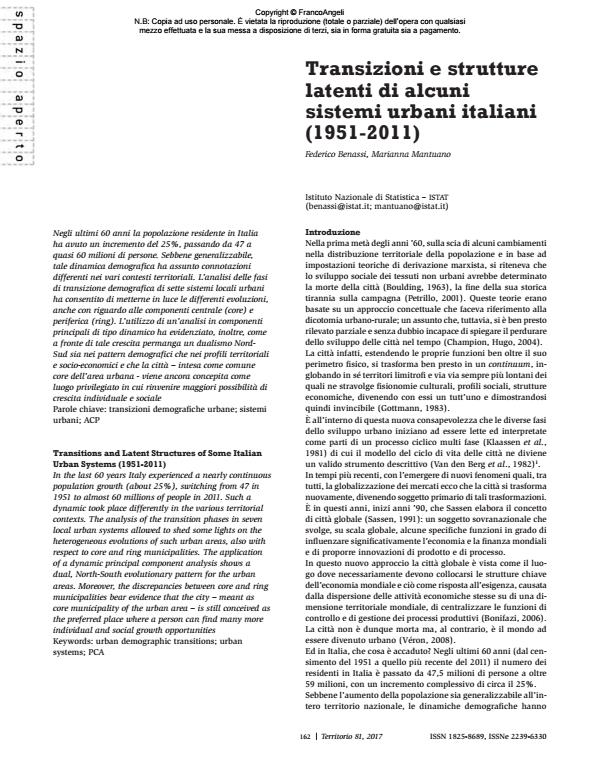Transitions and Latent Structures of Some Italian Urban Systems (1951-2011)
Journal title TERRITORIO
Author/s Federico Benassi, Marianna Mantuano
Publishing Year 2017 Issue 2017/81
Language Italian Pages 11 P. 162-172 File size 963 KB
DOI 10.3280/TR2017-081031
DOI is like a bar code for intellectual property: to have more infomation
click here
Below, you can see the article first page
If you want to buy this article in PDF format, you can do it, following the instructions to buy download credits

FrancoAngeli is member of Publishers International Linking Association, Inc (PILA), a not-for-profit association which run the CrossRef service enabling links to and from online scholarly content.
In the last 60 years Italy experienced a nearly continuous population growth (about 25%), switching from 47 in 1951 to almost 60 millions of people in 2011. Such a dynamic took place differently in the various territorial contexts. The analysis of the transition phases in seven local urban systems allowed to shed some lights on the heterogeneous evolutions of such urban areas, also with respect to core and ring municipalities. The application of a dynamic principal component analysis shows a dual, North-South evolutionary pattern for the urban areas. Moreover, the discrepancies between core and ring municipalities bear evidence that the city - meant as core municipality of the urban area - is still conceived as the preferred place where a person can find many more individual and social growth opportunities
Keywords: Urban demographic transitions; urban systems; PCA
- Spatial Heterogeneities or Inequalities? Health Care Supply and Demand of the Older Population in Italy Federico Benassi, Cecilia Tomassini, Giuseppe Di Felice, in Applied Spatial Analysis and Policy 44/2025
DOI: 10.1007/s12061-025-09647-5 - Le dinamiche occupazionali in italia alla luce di classificazioni non standard di geografie funzionali Federico Benassi, Marianna Mantuano, Alessandro Martini, Federica Pintaldi, in ECONOMIA E SOCIETÀ REGIONALE 1/2019 pp.121
DOI: 10.3280/ES2019-001009 - In-between centers and suburbs? Increasing differentials in recent demographic dynamics of Italian metropolitan cities Alessio Buonomo, Federico Benassi, Gerardo Gallo, Luca Salvati, Salvatore Strozza, in Genus 1/2024
DOI: 10.1186/s41118-023-00209-6
Federico Benassi, Marianna Mantuano, Transizioni e strutture latenti di alcuni sistemi urbani italiani (1951-2011) in "TERRITORIO" 81/2017, pp 162-172, DOI: 10.3280/TR2017-081031